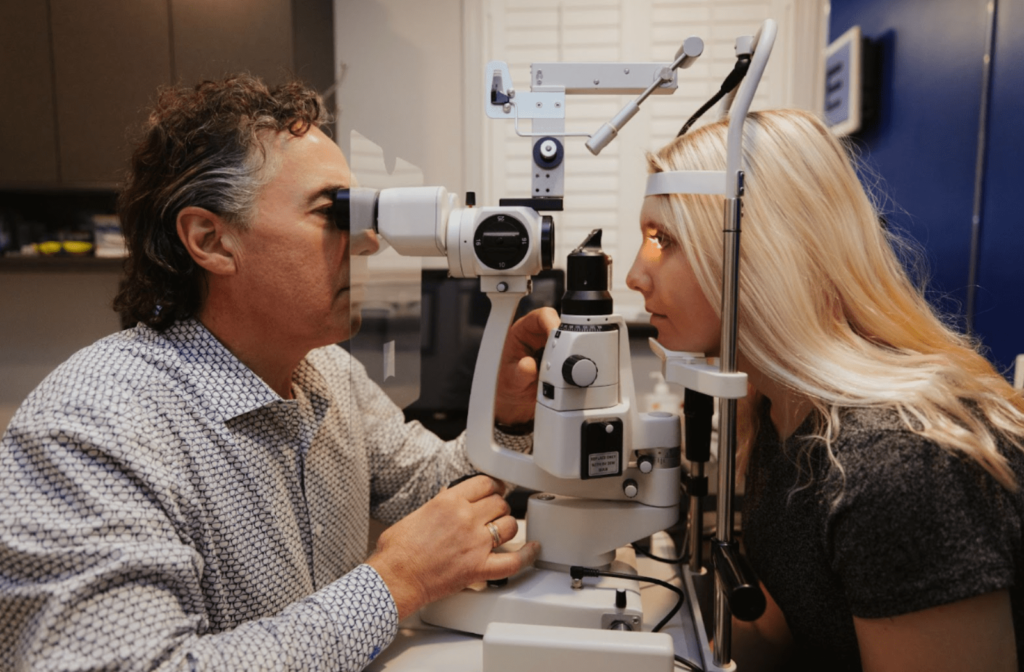Preventive healthcare includes regular eye and vision examinations because many eye and vision problems have no obvious symptoms or signs. Some vision issues can be detected during an eye exam that you may not think of, including diabetes.
Vision loss can be avoided if eye and vision problems are detected and treated early. The tests performed are based on the signs and symptoms of each patient as well as your optometrist’s professional judgment.
These tests range from simple to complex, such as having you read an eye chart or using a high-powered lens to capture images of the tiny structures inside your eyes.
What Happens During a Comprehensive Eye Exam?
An individual patient’s signs and symptoms, as well as the optometrist’s professional judgment, can significantly influence the testing done during a comprehensive eye exam. A thorough adult eye examination may include, but is not limited to, the following tests:
- Health background
- Visual acuity testing
- Preliminary evaluations of
- Vision and eye health
- Colour vision
- Depth perception
- Peripheral vision
- Pupil response to light
- Eye focusing, teaming, and movement
Health Background
People tend to believe that optometrists only need to know about a family history of eye problems. This is not untrue; you should always inform your optometrist of any eye diseases in your family. However, many people are unaware that eye doctors are also looking for diseases that may appear unrelated to eye health.
Your body is a machine made up of many smaller systems. While your heart and eye health may appear unrelated, these and other systems are interconnected, and they can all have a significant impact on one another.
Visual Acuity Testing
A visual acuity test is a simple and quick procedure. Your eye doctor may use a piece of equipment covered in dials, switches, and lenses, called a phoropter, to test your sight. It’s probably the first thing that comes to mind when you think of an eye exam.
The optometrist will instruct you to use the phoropter to look at a vision chart that is either 20 feet away or appears to be 20 feet away when reflected in a mirror. This chart, which is covered in bold, black letters that are larger at the top and gradually get smaller as they move down, may be familiar to you.
The lens powers on the phoropter will be adjusted by the optometrist, shifting or flipping them back and forth to determine your prescription.
Colour Vision
Your optometrist will perform a colour vision exam in a well-lit room with one of your eyes covered. You will then view a series of cards with multiple dots on them.
These cards will contain patterns, letters, or numbers that those who can see the entire colour spectrum will recognize, but those who have a colour vision impairment may struggle to see.
The test will be repeated with the other eye, as it’s possible to have colour vision loss in one eye but not the other.
Depth Perception
Stereopsis is the term used to describe how your eyes work together to perceive 3-dimensional objects. There are many different types of depth perception tests, but the most common one involves looking at test patterns while wearing 3D glasses.
Your task is to identify which of the objects in each pattern appears to be closest to you. If you can correctly identify the “closer” object in each pattern, your depth perception may be performing well.
Peripheral Vision
A visual field test can tell you if you have blind spots in your vision (called scotoma) and where they are. The size and shape of a scotoma can reveal how an eye disease or a brain disorder is affecting your vision.
For example, if you have glaucoma, this test can detect potential peripheral vision loss caused by the disease.
OCT Scanning & Images
Optical coherence tomography (OCT) is a noninvasive imaging method that uses reflected light to create pictures of the back of your eye.
OCT scans are important because your eye doctor can use the images to diagnose other health issues related to your eyes, like diabetes-related retinopathy and glaucoma.
Pupillary Response to Light
The doctor may ask you to look at a distant object after dimming the lights to check your pupillary response to light. From either side, they will shine a beam of light into your eyes to carefully examine your pupils to see if they constrict in response to light, noting their size and shape.
Eye Focusing, Teaming, & Movement
Visual skills are needed to help take in the world around us. Your eyes need to focus properly, work together (teaming), and move seamlessly to provide you with the picture you see.
The doctor will first go over your medical and eye history, paying special attention to any visual problems or symptoms. This data is used to customize the functional vision exam, which includes tests on a variety of visual skills.
Book a Comprehensive Eye Exam
When was the last time you had a comprehensive eye exam? When it’s time to have a checkup of your ocular health, book an appointment with York Mills Eye Care.




